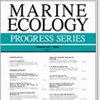幼鱼对不同结构复杂性海草的视觉生境选择
IF 2.1
3区 环境科学与生态学
Q2 ECOLOGY
引用次数: 0
摘要
摘要:海草草甸为各种鱼类提供了育苗栖息地,从而为生态系统提供了重要的服务。然而,对驱动这一功能的生境特征的探索仍然不够。然而,这些知识对于量化生态系统服务的提供、为恢复工作提供信息以及解决生境丧失和破碎化对这一关键沿海生境的影响至关重要。在这项研究中,对通常与海草床有联系的 2 种地中海幼鱼(东大西洋孔雀鱼 Symphodus tinca 和环纹鲷 Diplodus annularis)进行了生境选择实验,以评估它们是否会根据海草生境结构的复杂性主动选择海草生境。在一个实验水族箱中,当幼鱼目视多种人工栖息地配置时,记录并跟踪它们的活动,以确定它们在每种栖息地附近花费的时间比例。与无植被区域相比,两种鱼类都对有植被(模拟海草)的栖息地表现出明显的亲和力,这表明幼鱼能利用视觉线索区分并主动选择栖息地。然而,它们对日益复杂的模拟海草生境的占有模式却表现出不同的反应。D. annularis对复杂性的增加做出了积极反应,而S. tinca则没有。这些物种间的亲缘关系差异表明,以往野外研究中发现的不同栖息地之间幼体丰度的差异可能部分受主动栖息地选择的影响。了解不同物种对海草结构变化的反应对于量化其育苗服务至关重要。此外,在地中海环境变化的背景下,这些知识对于评估它们对海草消失的潜在脆弱性也至关重要。本文章由计算机程序翻译,如有差异,请以英文原文为准。
Visual habitat selection by juvenile fish in response to seagrass with different structural complexity
ABSTRACT: Seagrass meadows fulfil an essential ecosystem service by providing nursery habitats to various fish species. However, the habitat features driving this function remain insufficiently explored. Nevertheless, this knowledge is essential to quantify the ecosystem service provision, inform restoration efforts, and address the impact of habitat loss and fragmentation on this key coastal habitat. In this study, habitat selection experiments were conducted with 2 Mediterranean juvenile fish species (the East Atlantic peacock wrasse Symphodus tinca and the annular seabream Diplodus annularis), usually associated with Posidonia oceanica beds, to evaluate if they actively select seagrass habitats based on their structural complexity. Juvenile fish movement was recorded and tracked when visually exposed to multiple artificial habitat configurations within an experimental aquarium to determine the proportion of time spent near each habitat. Both species exhibited a clear affinity towards vegetated (seagrass mimics) habitats in comparison to unvegetated areas, demonstrating that juveniles distinguished and actively selected habitats using visual cues. However, they presented different responses in their occupancy patterns to increasing complexity of seagrass mimic habitats. While D. annularis responded positively to increases in complexity, S. tinca did not. These affinity variations between species suggest that differences in juvenile abundance between habitats found in previous field studies may be partially conditioned by active habitat choices. Understanding how different species respond to changes in seagrass structure is crucial for quantifying their nursery provision service. Moreover, this knowledge is essential to assess their potential vulnerability to seagrass loss in the context of environmental changes in the Mediterranean.
求助全文
通过发布文献求助,成功后即可免费获取论文全文。
去求助
来源期刊

Marine Ecology Progress Series
环境科学-海洋学
CiteScore
5.30
自引率
8.00%
发文量
238
审稿时长
3 months
期刊介绍:
The leading journal in its field, MEPS covers all aspects of marine ecology, fundamental and applied. Topics covered include microbiology, botany, zoology, ecosystem research, biological oceanography, ecological aspects of fisheries and aquaculture, pollution, environmental protection, conservation, and resource management.
 求助内容:
求助内容: 应助结果提醒方式:
应助结果提醒方式:


